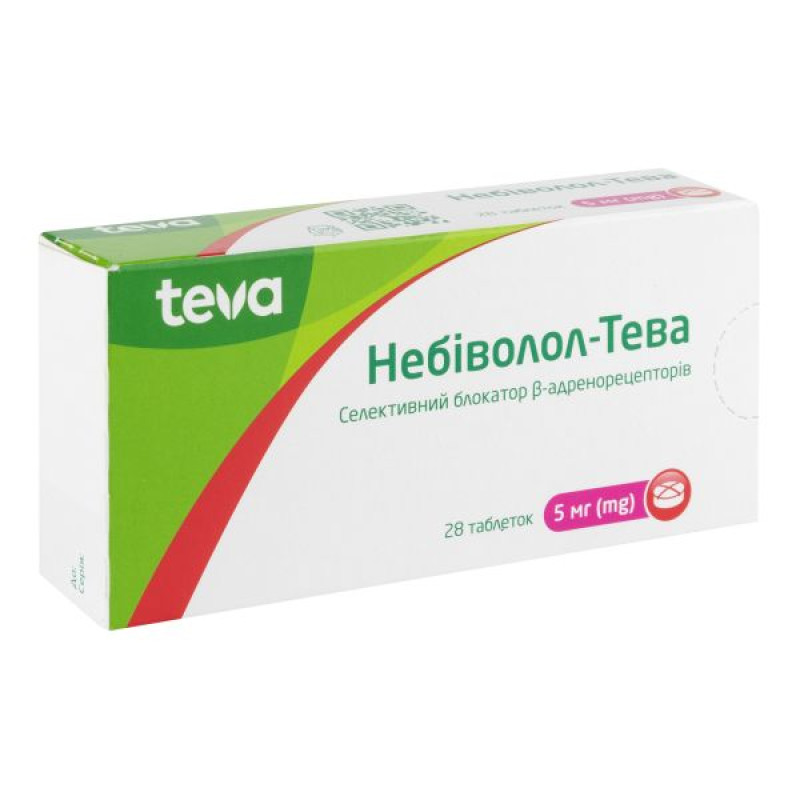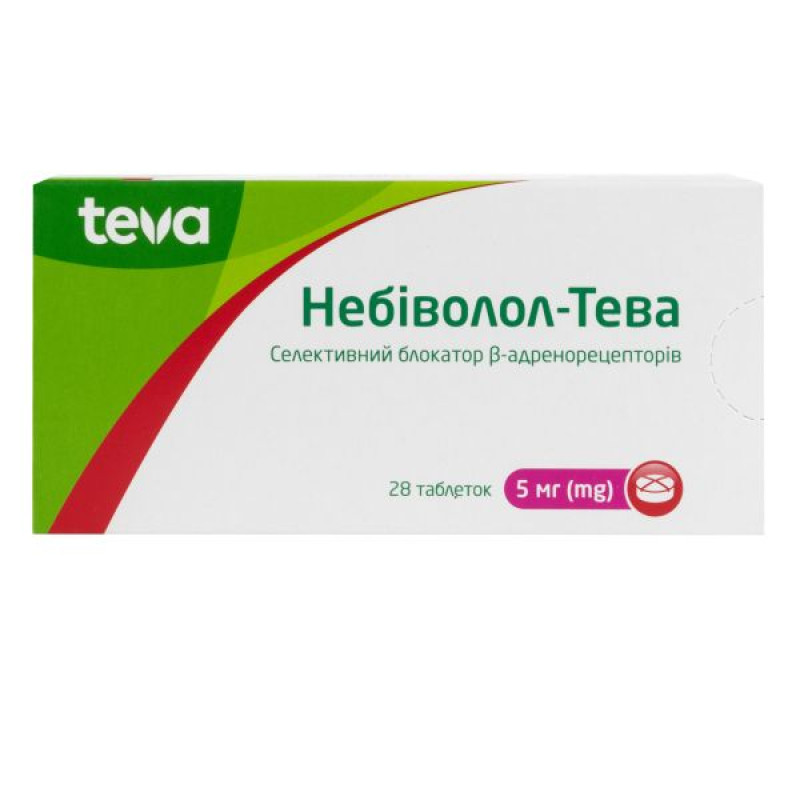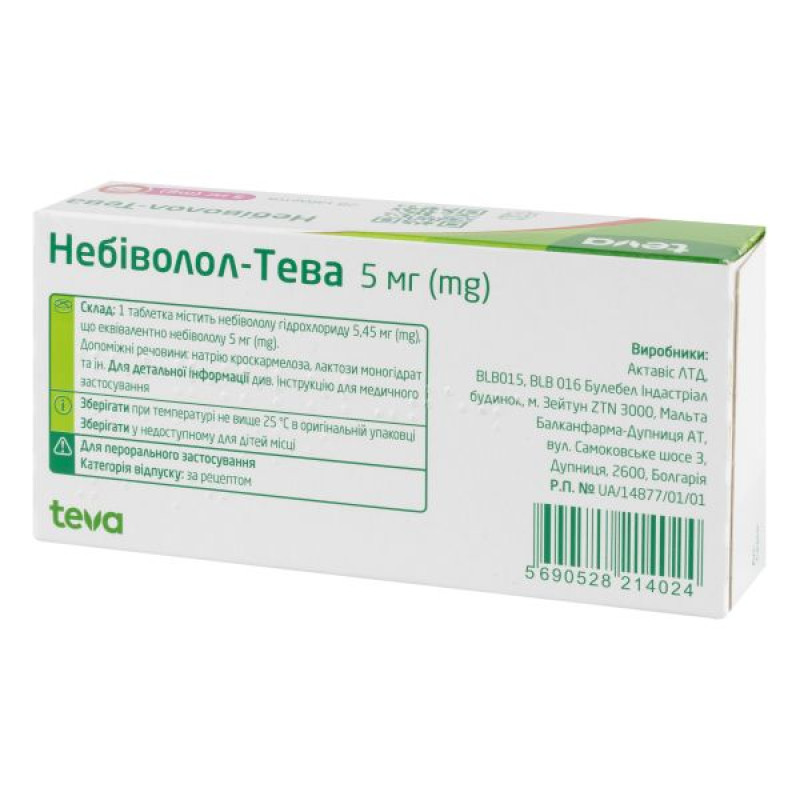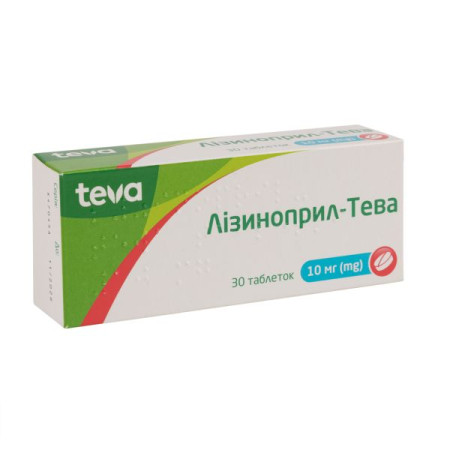Nebivolol-Teva tablets 5 mg blister No. 28

Instructions for Nebivolol-Teva tablets 5 mg blister No. 28
Composition
active ingredient: nebivolol;
1 tablet contains nebivolol hydrochloride 5.45 mg, which is equivalent to nebivolol 5 mg;
excipients: colloidal anhydrous silicon dioxide, magnesium stearate, croscarmellose sodium, macrogol 6000, lactose monohydrate.
Dosage form
Pills.
Main physicochemical properties: round, white, convex tablets with a cross-shaped notch on one side and marked "N5" on the other side.
Pharmacotherapeutic group
Selective β-adrenergic blockers. ATC code C07A B12.
Pharmacological properties
Pharmacodynamics
Nebivolol is a racemate consisting of two enantiomers: SRRR-nebivolol (D-nebivolol) and RSSS-nebivolol (L-nebivolol). It combines two pharmacological properties:
Due to the D-enantiomer, nebivolol is a competitive and selective β1-adrenoceptor blocker; due to the L-enantiomer, it exhibits mild vasodilating properties due to metabolic interaction with L-arginine/nitric oxide (NO).
With single and repeated use of nebivolol, the heart rate at rest and during exercise decreases in both normotensive and hypertensive individuals. The antihypertensive effect is maintained during long-term treatment.
At therapeutic doses, α-adrenergic antagonism is not observed.
During short-term and long-term treatment with nebivolol in patients with arterial hypertension, systemic vascular resistance decreases. Despite the decrease in heart rate, the decrease in cardiac output at rest and during exercise is limited due to the increase in stroke volume. The clinical significance of this hemodynamic difference compared with other β-adrenergic blockers is not yet sufficiently studied.
In patients with arterial hypertension, nebivolol increases the vascular response to acetylcholine mediated by nitric oxide; in patients with endothelial dysfunction, this response is reduced.
In a placebo-controlled study of 2128 patients ≥70 years of age (mean age 75.2 years) with stable chronic heart failure with or without reduced left ventricular ejection fraction, nebivolol as an add-on to standard therapy significantly prolonged the time to death or cardiovascular-related hospitalization. The effect of nebivolol was independent of age, gender, or left ventricular ejection fraction in the study participants. A reduction in the incidence of sudden death was observed in patients receiving nebivolol.
Pharmacokinetics
Absorption: After oral administration, both enantiomers of nebivolol are rapidly absorbed. The absorption of nebivolol is not affected by food, so it can be taken regardless of food intake.
Metabolism. Nebivolol is completely metabolized, partly with the formation of active hydroxymetabolites. The metabolism of nebivolol occurs by acyclic or aromatic hydroxylation, N-dealkylation and glucuronidation; in addition, glucuronides of hydroxymetabolites are formed. The metabolism of nebivolol by hydroxylation is subject to genetic oxidative polymorphisms, which depend on CYP2D6. The bioavailability of orally administered nebivolol is on average 12% in extensive metabolizers and is almost complete in poor metabolizers. At steady-state and at the same dose, the maximum plasma concentration of unchanged nebivolol is approximately 23 times higher in poor metabolizers than in extensive metabolizers. Considering the sum of the unchanged drug and its active metabolites, the difference in maximum plasma concentrations is 1.3 to 1.4 times. Based on the difference in metabolic rates, the dosage of nebivolol should be adjusted to the individual needs of the patient; individuals with slow metabolizers may require lower doses.
In extensive metabolizers, the half-life of the enantiomers of nebivolol is on average 10 hours, while in poor metabolizers this value is 3-5 times higher. In extensive metabolizers, the concentration of the RSSS enantiomer is slightly higher than that of the SRRR enantiomer. In poor metabolizers, this difference is greater. In extensive metabolizers, the half-life of the hydroxy metabolites of both enantiomers is on average 24 hours, while in poor metabolizers this value is approximately 2 times higher.
Steady-state plasma concentrations of nebivolol are reached within 24 hours in most patients (rapid metabolizers), and steady-state concentrations of hydroxymetabolites are reached within a few days. Plasma concentrations are dose-proportional over the dose range of 1 to 30 mg nebivolol. Age does not affect the pharmacokinetics of nebivolol.
In plasma, both enantiomers of nebivolol are predominantly bound to albumin. Plasma protein binding is 98.1% for D-nebivolol and 97.9% for L-nebivolol.
Excretion: One week after administration, 38% of the dose is excreted in the urine and 48% in the feces. Urinary excretion of unchanged nebivolol is less than 0.5% of the dose.
Indication
Stable chronic heart failure of mild to moderate severity, as an adjunct to standard therapy for patients aged 70 years and older.
Contraindication
Hypersensitivity to the active substance or to any of the other components of the drug; hepatic failure or impaired liver function; acute heart failure, cardiogenic shock or episodes of decompensated heart failure requiring intravenous administration of active substances with a positive inotropic effect.
In addition, like other β-blockers, Nebivolol-Teva is contraindicated in:
sick sinus syndrome, including sinoatrial block; AV block II-III degree (without an artificial pacemaker); bronchospasm and bronchial asthma in history; untreated pheochromocytoma; metabolic acidosis; bradycardia (before the start of treatment, the heart rate is less than 60 beats/min); arterial hypotension (systolic blood pressure less than 90 mm Hg); severe peripheral circulatory disorders.
Interaction with other medicinal products and other types of interactions
Pharmacodynamic interactions
The following interactions are common to beta-adrenergic blockers.
Concomitant use is not recommended:
with class I antiarrhythmic drugs (quinidine, hydroquinidine, cibenzoline, flecainide, disopyramide, lidocaine, mexiletine, propafenone): the effect on AV conduction may be enhanced and the negative inotropic effect may increase (see section "Special instructions for use");
with calcium channel blockers such as verapamil and diltiazem: negative effect on AV conduction and myocardial contractility; intravenous administration of verapamil to patients taking β-blockers may lead to significant arterial hypotension and AV block (see section "Special instructions for use");
with centrally acting antihypertensive drugs (clonidine, guanfacine, moxonidine, methyldopa, rilmenidine): may lead to increased heart failure due to a decrease in the tone of the central sympathetic nervous system (decrease in heart rate and stroke volume, vasodilation) (see section "Special precautions for use"); with sudden withdrawal, in particular before the end of the use of β-blockers, the likelihood of an increase in blood pressure (withdrawal syndrome) may increase.
Caution should be exercised when using simultaneously:
with class III antiarrhythmic drugs (amiodarone): the effect on AV conduction may be increased;
with halogenated volatile anesthetics: may suppress reflex tachycardia and increase the risk of arterial hypotension (see section "Special instructions for use"); as a general rule, sudden withdrawal of β-blocker treatment should be avoided; if the patient is using Nebivolol-Teva, the anesthesiologist should be informed;
with insulin and oral antidiabetic agents: although nebivolol does not affect blood glucose levels, when used concomitantly it may mask symptoms of hypoglycemia such as tachycardia and palpitations; with baclofen (antispastic agent), amifostine (adjuvant in antitumor therapy): their simultaneous use with antihypertensive agents may lead to a significant decrease in blood pressure, so the dose of antihypertensive agents should be adjusted accordingly.
It should be noted that when used together:
with digitalis glycosides: atrioventricular conduction time may increase, during clinical studies there were no signs of this interaction; nebivolol does not affect the kinetics of digoxin; with dihydropyridine-type calcium antagonists (amlodipine, felodipine, lacidipine, nifedipine, nicardipine, nimodipine, nitrendipine): the risk of hypotension may increase, and in patients with heart failure an increase in the risk of further deterioration of ventricular pumping function cannot be excluded; with antipsychotics, antidepressants (tricyclic antidepressants, barbiturates, phenothiazine derivatives), organic nitrates and other antihypertensive agents: the hypotensive effect of beta-blockers may be enhanced (additive effect); with non-steroidal anti-inflammatory drugs: there is no effect on the antihypertensive effect of nebivolol; with sympathomimetics: may counteract the antihypertensive effect of β-blockers; active substances with β-adrenergic action may lead to unhindered α-adrenergic activity of sympathomimetics with both α- and β-adrenergic effects (risk of developing arterial hypertension, severe bradycardia and heart block).
Since the CYP2D6 isoenzyme is involved in the metabolism of nebivolol, the combined use of drugs that inhibit this enzyme (paroxetine, fluoxetine, thioridazine, quinidine, terbinafine, bupropion, chloroquine and levomepromazine) may increase the level of nebivolol in the blood plasma and, thus, increase the risk of excessive bradycardia and other adverse reactions; cimetidine increases the level of nebivolol in the blood plasma, but without changing the clinical efficacy; ranitidine does not affect the pharmacokinetics of nebivolol; provided that nebivolol is used during meals, and the antacid is taken between meals, these drugs can be prescribed together; when nebivolol and nicardipine are used together, the concentration of both drugs in the blood plasma slightly increased without changing the clinical efficacy; simultaneous use of alcohol, furosemide or hydrochlorothiazide does not affect the pharmacokinetics of nebivolol; Nebivolol does not affect the pharmacodynamics and pharmacokinetics of warfarin.
Application features
The following warnings and precautions are common to beta-adrenergic blockers.
Anesthesia.
Maintaining β-blockade reduces the risk of cardiac arrhythmias during induction of anesthesia and intubation. If β-blockade must be discontinued in preparation for surgery, β-blockers should be discontinued at least 24 hours in advance. Caution is required when using certain anesthetics that cause myocardial depression. Vagal reactions in the patient can be prevented by intravenous atropine.
Cardiovascular system.
Patients with untreated chronic heart failure are usually not given β-blockers until their condition is stable.
In patients with coronary artery disease, β-blocker therapy should be discontinued gradually, i.e. over 1-2 weeks. If necessary, it is recommended to start treatment with a replacement drug at the same time to prevent exacerbation of the disease.
Beta-blockers can cause bradycardia. If the resting heart rate decreases to 50-55 beats per minute and/or the patient develops symptoms suggestive of bradycardia, it is recommended that the dose be reduced.
β-adrenergic blockers should be used with caution in the treatment of:
patients with peripheral circulatory disorders (Raynaud's disease or syndrome, intermittent claudication), as exacerbation of these diseases may develop; patients with first-degree atrioventricular block due to the negative effect of β-adrenergic blockers on conduction; patients with Prinzmetal's angina due to unobstructed vasoconstriction of the coronary arteries mediated through α-adrenergic blockers: β-adrenergic blockers may increase the frequency and duration of angina attacks.
The combination of nebivolol with calcium channel blockers such as verapamil and diltiazem, with group I antiarrhythmics, as well as with centrally acting antihypertensives is not recommended at all (for detailed information, see the section "Interaction with other medicinal products and other types of interactions").
Metabolism and endocrine system.
Nebivolol does not affect blood glucose levels in patients with diabetes mellitus. However, caution should be exercised when using it to treat patients in this category, as nebivolol may mask some signs of hypoglycemia, such as tachycardia and palpitations.
Beta-blockers may mask the symptoms of tachycardia in hyperthyroidism. These symptoms may worsen if therapy is abruptly discontinued.
Respiratory system.
In patients with chronic obstructive airways disease, β-blockers should be used with caution as airway constriction may be exacerbated.
Other recommendations.
Patients with a history of psoriasis should be prescribed β-blockers only after careful consideration.
Beta-adrenergic blockers may increase sensitivity to allergens and the severity of anaphylactic reactions.
Beta-adrenergic blockers may cause decreased tear production (information for contact lens wearers).
At the beginning of treatment with nebivolol for chronic heart failure, regular monitoring of the patient is necessary. Treatment should not be stopped abruptly unless absolutely necessary (see section "Method of administration and dosage").
The drug contains lactose monohydrate, so it should not be taken by patients with hereditary galactose intolerance, lactase deficiency or glucose-galactose malabsorption syndrome.
Ability to influence reaction speed when driving vehicles or other mechanisms
Studies on the effect on the speed of reaction when driving vehicles or other mechanisms have not been conducted. Pharmacodynamic studies have shown that nebivolol does not affect psychomotor function. When driving vehicles or other mechanisms, it should be taken into account that dizziness and fatigue may occasionally occur (see section "Adverse reactions").
Use during pregnancy or breastfeeding
Nebivolol has pharmacological effects that may have adverse effects on pregnancy and/or the fetus/newborn. In general, β-blockers reduce placental blood flow, which has been associated with growth retardation, intrauterine death, miscarriage and premature birth. Adverse effects (e.g. hypoglycemia and bradycardia) may occur in the fetus and newborn. If treatment with β-blockers is necessary, β1-selective β-blockers are preferable.
Nebivolol should not be used during pregnancy unless clearly necessary. If treatment with nebivolol is considered necessary, uteroplacental circulation and foetal growth should be monitored. If harmful effects on pregnancy or foetus are observed, alternative treatment should be considered. The newborn infant should be closely monitored. Symptoms of hypoglycaemia and bradycardia can generally be expected within the first 3 days.
Breastfeeding period.
Animal studies have shown that nebivolol passes into breast milk. It is not known whether this substance passes into human breast milk. Most β-blockers, namely lipophilic compounds such as nebivolol and its active metabolites, pass into breast milk, although to varying degrees. Therefore, breastfeeding is not recommended during treatment with nebivolol.
Method of administration and doses
Administer orally. Swallow the tablets or part of a tablet with a sufficient amount of liquid (e.g. 1 glass of water). The drug is taken regardless of meals.
Essential hypertension.
Adult patients should take 1 tablet (5 mg) of Nebivolol-Teva per day, if possible at the same time. The hypotensive effect becomes apparent after 1-2 weeks of treatment, but sometimes the optimal effect is observed only after 4 weeks.
Combination with other antihypertensive agents. Nebivolol-Teva can be used as monotherapy or in combination with other antihypertensive agents. To date, an additional hypotensive effect has only been observed when the drug is combined with 12.5-25 mg of hydrochlorothiazide.
Patients with renal insufficiency. The recommended initial dose is 2.5 mg per day. If necessary, the daily dose can be increased to 5 mg.
Patients with hepatic insufficiency. Experience in such patients is limited, therefore nebivolol is contraindicated.
Elderly patients (aged 65 years and over). For this group of patients, the recommended initial dose is 2.5 mg per day, if necessary it can be increased to 5 mg. Due to insufficient experience with the drug in patients aged 75 years and over, its use requires caution and careful monitoring.
Chronic heart failure.
Treatment of chronic heart failure should begin with slow titration of the dose until the individual optimal maintenance dose is achieved. Such patients should be prescribed the drug if chronic heart failure is observed without episodes of its acute decompensation within the last 6 weeks. It is recommended that the physician has experience in the treatment of chronic heart failure.
Patients taking other cardiovascular drugs (including diuretics and/or digoxin and/or angiotensin-converting enzyme (ACE) inhibitors and/or angiotensin II receptor antagonists) should have their doses of these drugs adjusted for the last 2 weeks before starting nebivolol. Initial dose titration should be carried out according to the following scheme, maintaining intervals of 1 to 2 weeks and focusing on the patient's tolerability of the dose: 1.25 mg nebivolol per day can be increased to 2.5 mg nebivolol once a day, then to 5 mg once a day, and then to 10 mg once a day. The maximum recommended dose is 10 mg once a day.
At the beginning of treatment and with each dose increase, the patient should be under the supervision of an experienced physician for at least 2 hours to ensure that the clinical condition remains stable (especially blood pressure, heart rate, myocardial conduction disturbances, and worsening of heart failure symptoms).
The occurrence of side effects may prevent treatment with the maximum recommended dose in all patients. If necessary, the dose already reached can be gradually reduced again or returned to it again.
If symptoms of heart failure worsen or if the drug is not tolerated during the titration phase, it is recommended to first reduce the dose of nebivolol or, if necessary, immediately discontinue the drug (if severe hypotension occurs, symptoms of heart failure worsen with acute pulmonary edema, cardiogenic shock, symptomatic bradycardia or AV block occur).
Patients with renal insufficiency. Since titration to the maximum tolerated dose is individual, no dose adjustment is required in mild to moderate renal insufficiency. There is no experience in patients with severe renal insufficiency (serum creatinine ≥250 μmol/l), therefore the use of nebivolol in such patients is not recommended.
Patients with hepatic insufficiency. Nebivolol is contraindicated in patients with hepatic insufficiency due to limited experience.
Elderly patients (aged 65 years and over): No dose adjustment is required, as titration to the maximum tolerated dose is performed individually.
Children
Studies on the use of the drug in children under 18 years of age have not been conducted, therefore the use of the drug is not recommended for this age group.
Overdose
No data are available regarding overdose with nebivolol.
Symptoms: Overdose of β-blockers is observed: bradycardia, hypotension, bronchospasm, acute heart failure.
Treatment of overdose. In case of overdose or hypersensitivity reactions, it is necessary to ensure constant monitoring of the patient and treatment in the intensive care unit. It is necessary to monitor the blood glucose level. The absorption of any drug still in the gastrointestinal tract is prevented by gastric lavage, the use of activated charcoal and laxatives. Artificial ventilation of the lungs may also be required. In case of bradycardia or increased vagotonia, atropine or methylatropine should be used, in case of hypotension and shock, plasma/plasma substitutes should be administered intravenously, and, if necessary, catecholamines.
Beta-blocking effect can be reversed by slow intravenous administration of isoprenaline hydrochloride starting at 5 mcg/min or dobutamine starting at 2.5 mcg/min until the desired effect is achieved. In refractory cases, isoprenaline can be combined with dopamine. If the above measures do not help, glucagon can be administered intravenously at a rate of 50-100 mcg/kg. If necessary, the injection can be repeated within an hour and, if necessary, an intravenous infusion of glucagon at a rate of 70 mcg/kg/hour can be given. In extreme cases, when bradycardia is not amenable to treatment, an artificial pacemaker may be required.
Adverse reactions
Adverse reactions in hypertension and chronic heart failure are listed separately due to the difference in the underlying diseases of these conditions.
Arterial hypertension
Adverse reactions, which were mostly mild to moderate in severity, are listed in the table below; they are classified according to organ system and frequency of occurrence.
| Organ system disorders | Common (≥1/100 and <1/10) | Uncommon (≥1/1000 and <1/100) | Very rare (<1/10,000) | Frequency not known (cannot be estimated from the available data) |
| On the part of the immune system | Angioedema, hypersensitivity | |||
| From the psyche | Terrible dreams, depression | |||
| From the nervous system | Headache, dizziness, paresthesia | Syncope | ||
| From the organs of vision | Vision impairment | |||
| From the heart | Bradycardia, heart failure, AV conduction delay/AV block | |||
| From the vascular side | Arterial hypotension, increased intermittent claudication | |||
| Respiratory system | Dyspnea | Bronchospasm | ||
| From the digestive system | Constipation, nausea, diarrhea | Dyspepsia, flatulence, vomiting | ||
| Skin and subcutaneous tissue disorders | Pruritus, erythematous rash | Psoriasis flare-ups | Urticaria | |
| From the reproductive system | Impotence | |||
| General disorders | Increased fatigue, edema |
The following adverse reactions have also been reported with some β-blockers: hallucinations, psychosis, confusion, coldness/cyanosis of the extremities, Raynaud's syndrome, dry eyes, and practolol-type ocular-mucocutaneous toxicity.
Chronic heart failure.
The following adverse reactions have been reported, which were at least potentially related to the use of the medicinal product and were considered characteristic and significant in the treatment of chronic heart failure:
worsening heart failure was observed in 5.8% of patients taking nebivolol and 5.2% of patients taking placebo; orthostatic hypotension was observed in 2.1% of patients taking nebivolol and 1% of patients taking placebo; drug intolerance was observed in 1.6% of patients taking nebivolol and 0.8% of patients taking placebo; first degree AV block was observed in 1.4% of patients taking nebivolol and 0.9% of patients taking placebo; lower limb edema was observed in 1.0% of patients taking nebivolol and 0.2% of patients taking placebo.
Expiration date
3 years.
Storage conditions
Store at a temperature not exceeding 25 ºС in the original packaging.
Keep out of reach of children.
Packaging
14 tablets in a blister, 2 blisters in a cardboard box.
Vacation category
According to the recipe.
Producer
Balkanfarma-Dupnytsia JSC.
Location of the manufacturer and its business address.
3 Samokovskoe Shose St., Dupnitsa, 2600, Bulgaria.
There are no reviews for this product.
There are no reviews for this product, be the first to leave your review.
No questions about this product, be the first and ask your question.






